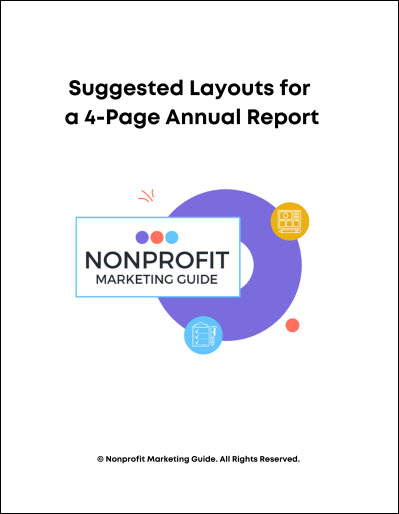We really push for you to create a shorter, more visual nonprofit annual report here as opposed to long print reports. Shorter annual reports don’t take as many resources, can be shared more easily, and will be read more often.
But whether you have an infographic, a video, a 4-page, or a 40-page annual report, there are five elements essential to a successful nonprofit annual report.
If you are looking to go shorter with your nonprofit annual report, be sure you also follow these 7 Planning Steps for a Short Annual Report.
Five Essential Elements for a Successful Nonprofit Annual Report
1. Accomplishments as Opposed to Activities
Donors really just want to know:
- What were the results of what you did?
- Why did you spend your time and money the way you did?
- What difference did it make?
Connect the everyday activities of your organization to your mission statement. Don’t assume that readers will automatically understand how your activities help you achieve your mission. Connect the dots for them.
Nonprofits often assume that an annual report is a description of activities. That’s not quite right. An annual report should be a summary of what you accomplished by doing those activities. You need to explain how what you do every day makes a difference in the world.
It’s the difference between saying you went to five meetings and explaining how something changed because you went to those five meetings. Don’t just say you released a study on a topic; explain how the study opened the eyes of a certain group of people and how their behaviors changed as a result.
2. Stories from the Real People You Serve
Supporters want to hear powerful stories about the impact of your work that feature real people. Include people pictures, profiles, testimonials, and little anecdotes that let those voices shine through. Get away from the institutional voice of the 501(c)(3) doing the talking, and make your nonprofit annual report a more personal communications piece.
Including personal profiles as sidebars or anecdotes in your annual report, or in a video online, is a great way to tell an important story about your organization, while also recognizing the contributions or successes of specific people. Asking others who have been touched by your organization to share their experiences is a proven way to share your accomplishments without sounding like you are bragging. Let them say how great you are. Use a “creative nonfiction” style of writing – storytelling where everything is true. Describe the scene and use vivid language to bring your reader into the story and help them visualize what’s happened.
3. The Financials Explained in Plain English
The financial section of your annual report needs to tell the story too.
Because nonprofit organizations are not legally required to produce an annual report – we are talking about the communications piece to donors, not government forms like your 990 — there are no requirements about how financial information should be presented in them. Some nonprofits choose to print their full financial statements in their annual reports, while others print only a few simple pie charts.
Printing full financials has drawbacks. Readers who are unfamiliar with financial statements will skip right over those big tables full of numbers. Even people who know how to read them may not take the time to examine the financials to draw out the meaning behind the numbers. Financial statements can be easily misinterpreted, especially if you have large one-time income and expense items that skew your bottom line. Finally, full financials take up lots of space, and because annual reports can be expensive to design, print, and mail, every page counts.
Unless you feel very strongly that your organization would benefit from printing your full financials, leave them out of your nonprofit annual report. Instead, use graphics and a short narrative description of how you raised and spent the money. Include a note that says that your full financials are available upon request or on your website.
4. Ample Thanks to Your Supporters
Thank your supporters. And then thank them so more. Your community of supporters should feel that you are embracing them as partners in bringing about all of the year’s accomplishments. In traditional reports, nonprofits often list all of the names of donors, but in shorter formats, that’s just not possible. Instead, use the stories you tell, the profiles and photos you include, and your overall tone to convey how important their support is to your success. This attitude of gratitude should permeate the entire report.
5. A Call to Action
So you’ve done a fabulous job telling readers about your accomplishments and financials and inspiring them to get involved in helping you do more. What next? Tell your readers exactly how they can help you. Include a small box or a full page at the end of the report (or a link or form online) with a call to action or request for help. Let readers know the different ways they can support your organization.
You can list the types of donations you can accept. For example, can you accept gifts of stock? Do you offer charitable gift annuities or other planned giving tools? Do you acknowledge memorial gifts with a card to the family as well as the donor? This is also a good place to mention workplace giving opportunities such as your membership in federated campaigns like United Way. You can also share other non-monetary ways people can support you such as volunteering or simply following you on social media
While we encourage you to experiment with different formats, as long as you include these five elements, your nonprofit annual report will be a success!
For more, see Nonprofit Annual Report Best Practices, Example, and Templates.
Need an Annual Report Template?
Fill out the form below to get Suggested Layouts for a 4-Page Annual Report.

Suggested Layouts for a 4-Page Annual Report
Create a shorter annual report people will actually read using the layouts in this free download. By downloading this resource, you also consent to receive our weekly newsletter filled with marketing tips, insights, and more for nonprofit communicators.






